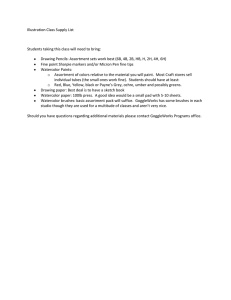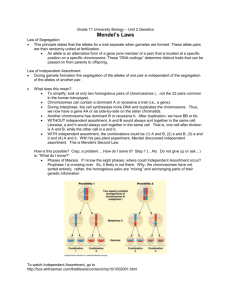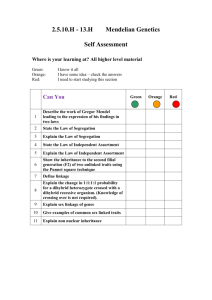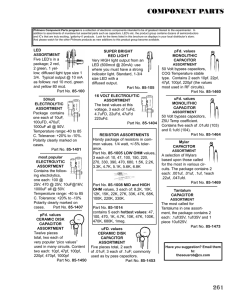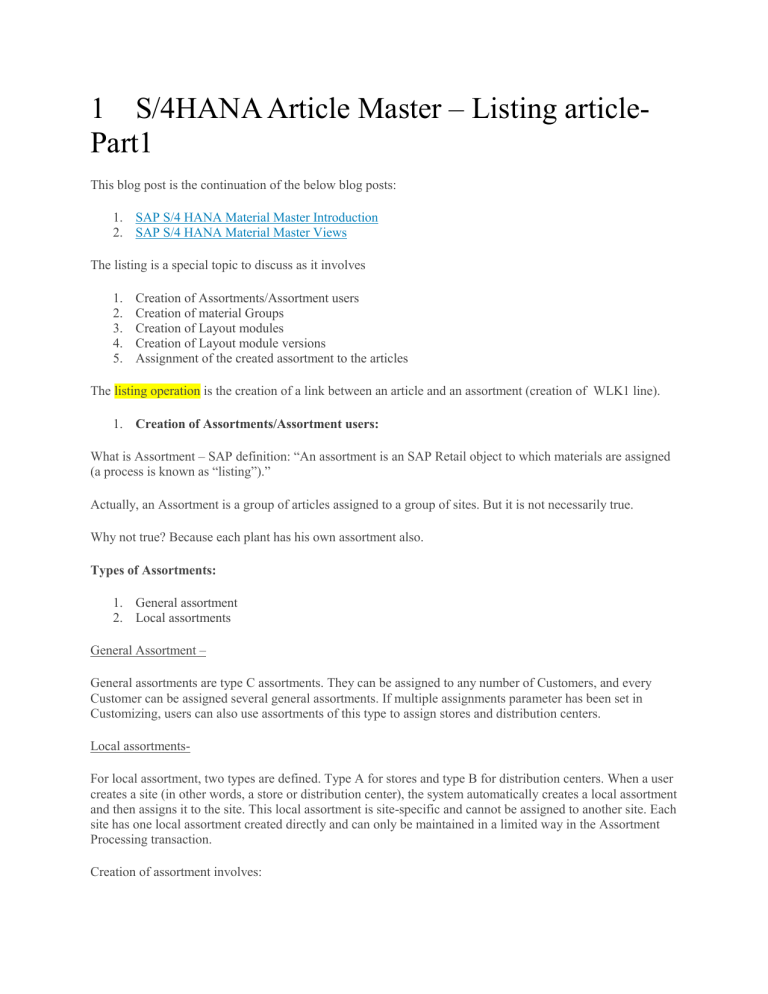
1 S/4HANA Article Master – Listing articlePart1 This blog post is the continuation of the below blog posts: 1. SAP S/4 HANA Material Master Introduction 2. SAP S/4 HANA Material Master Views The listing is a special topic to discuss as it involves 1. 2. 3. 4. 5. Creation of Assortments/Assortment users Creation of material Groups Creation of Layout modules Creation of Layout module versions Assignment of the created assortment to the articles The listing operation is the creation of a link between an article and an assortment (creation of WLK1 line). 1. Creation of Assortments/Assortment users: What is Assortment – SAP definition: “An assortment is an SAP Retail object to which materials are assigned (a process is known as “listing”).” Actually, an Assortment is a group of articles assigned to a group of sites. But it is not necessarily true. Why not true? Because each plant has his own assortment also. Types of Assortments: 1. General assortment 2. Local assortments General Assortment – General assortments are type C assortments. They can be assigned to any number of Customers, and every Customer can be assigned several general assortments. If multiple assignments parameter has been set in Customizing, users can also use assortments of this type to assign stores and distribution centers. Local assortmentsFor local assortment, two types are defined. Type A for stores and type B for distribution centers. When a user creates a site (in other words, a store or distribution center), the system automatically creates a local assortment and then assigns it to the site. This local assortment is site-specific and cannot be assigned to another site. Each site has one local assortment created directly and can only be maintained in a limited way in the Assortment Processing transaction. Creation of assortment involves: Creation of standard assortments for different sites Assignment of assortments to assortment users Creation of assortment modules and assignment to assortments An assortment user must be assigned to an assortment before it can use the articles in that assortment for its various business functions. The scope of functions available is determined by the category of assortment users. The following categories of assortment users are available: Retail sites Stores Distribution centers Customers The most important assortment user is the retail site. The assortments of a site consist of all the articles in which it trades. Assortments can be grouped together in the Classification System using SAP class type 047. Listing checks use only the characteristics defined here. Mass functions are available for assigning customers to assortments (using assortment maintenance functions and radio buttons). The main tasks in Assortment Management for retail sites and customers are: Determining the articles that may be sold in a store at POS. Adding these articles to the article assortment that is assigned to this store’s distribution center Determining the distribution centers via which articles are distributed when stores are to be supplied from the warehouse Determining the stores in which articles are to be sold at the point of sale Determining the articles which are to be included in the customer‘s assortments Steps to create Assortment: You can create general assortments and assign merchandise categories. 1. On the Create Assortment Initial Screen, enter a new assortment. 2. Give the assortment a key and a name. 3. Assign an assortment status. The validity period starts with the current date and is open-ended, for example, to the year 9999. Enter the distribution chain in which this assortment is to be used. Set the flag for creating listing conditions. Optional: Define a listing procedure to check the results of the listing process. Optional: Set the flag for listing all merchandise categories even if errors occur when the listing is checked. 8. Optional: Set a flag to specify that the system should only carry out listing checks on a layout assigned to the assortment. 4. 5. 6. 7. If such a check is carried out, you merely have to specify the layout in question. 9. Choose Merchandise categories and assign the merchandise categories to the assortment. If required, you can assign each merchandise category an assortment grade and/or an internal (systemside) assortment priority. 10. Save your entries. In the next blog post, we will see actual creation part of listing via different methods like Method1 1. Create an assortment module and assign materials 2. Assign the module(s) to the assortment (s) Method2 1. Promotional modules, rackjobbres Method3 1. Layout i. Create layout Modules and assign Materials ii. Assign Layout Modules to layout iii. Assign Layout to assortments In the next blog posts, we can discuss more on processing. S/4 HANA Article Master – Listing article-Part2 2 S/4 HANA Article Master – Listing articlePart2 This blog post is the continuation of the below blog posts: 1. SAP S/4 HANA Material Master Introduction 2. SAP S/4 HANA Material Master Views 3. S/4 HANA Article Master – Listing article-Part1 In this blog post, we will discuss the Listing of the article. The article listing can be done several ways as follows: Method1 1. Create an assortment module and assign materials 2. Assign the module(s) to the assortment (s) Method2 1. Promotional modules, rackjobbres Method3 1. Layout i. Create layout Modules and assign Materials ii. Assign Layout Modules to layout iii. Assign Layout to assortments Once creating is done – WLK1, WLK2, WLK3. Once only these tables updated. Let us discuss Method1 – it involves 2 steps: 1. Create an assortment module and assign materials 2. Assign the module(s) to the assortment (s) Creation of Assortment Module: Go to Transaction – WSO1 to create an assortment module Assortment Module Creation and then select the Module type as below Assortment Module type here we have different types of modules as below: 1. Standard Module – is relevant for being purchased or sold at the site 2. Exclusion module – you cannot buy material at a particular site 3. Rackjobber module – a functionality – vendors places at the store, it is not the property of inventory, only owes to the vendor, on a commission basis 4. Value contract module – standard sales and distribution based on contract
